Move over 46P/Wirtanen, it's time for the Geminids, the richest meteor shower of the year.
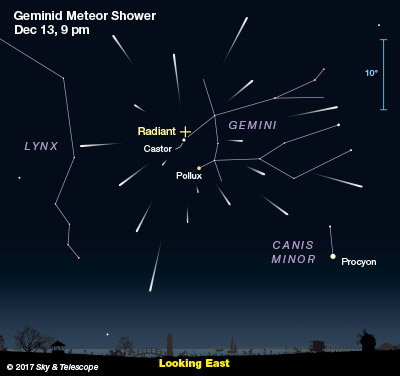
That's all it takes — just an hour. Then don't be surprised if you linger longer. I always do. Thursday night December 13–14 marks the peak of the annual Geminid meteor shower, when bits and pieces of the asteroid 3200 Phaethon speed into atmosphere at 127,000 kilometers per hour, etching the sky with fiery trails of glowing plasma.
In part because of cold weather, the Geminids don't get the attention of the Perseids, which occur during the more pleasant month of August. But it's the richer of the two showers and the richest of the year with a zenithal hourly rate (ZHR) of 120 meteors an hour. Just remember that ZHR is an idealized number based on the number of meteors one would see if the radiant were overhead in a very dark sky. Most of us will see closer to a third that number or less, if you're watching from a larger city.
I live in a moderately dark area with significant light pollution to the south-southwest. If I don't travel to darker skies, I typically spot between 30-40 Geminids per hour without interference from the Moon. No complaints here. That's plenty for a happy night.
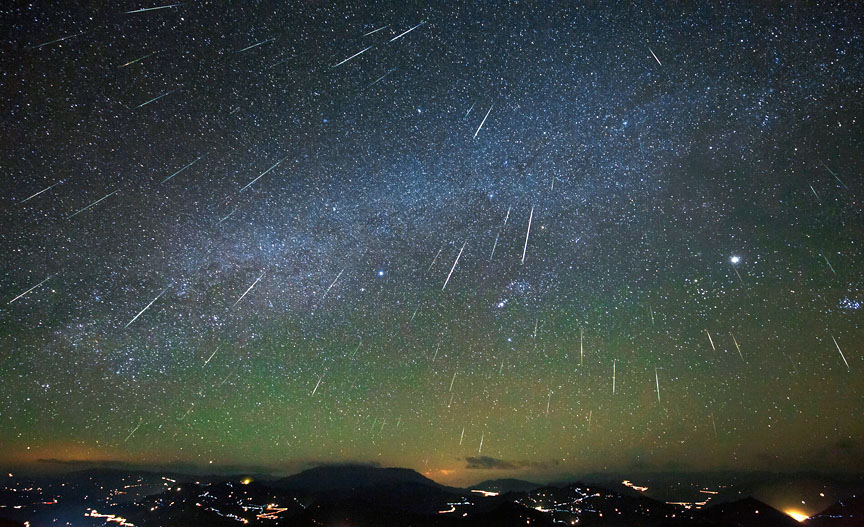
Getty Images / Stocktrek Images / Jeff Dai
If you're stuck in a bright location and want to see as many meteors as possible, find the closest dark skies by zooming in to your location on the Light Pollution Map. Then, search the surrounding region for pockets of darkness. The color coding and highway overlays make it easy to know what direction to go.
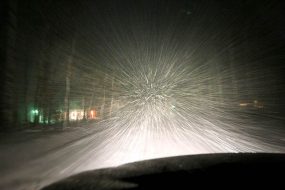
Bob King
This year's Geminids should provide an excellent show because the Moon won't be throwing light about. On the night of maximum, it will be 6 days old and set around 10:30 p.m. local time, just about the time the shower kicks into gear. Don't worry about starting a little earlier, especially if you have kids. The shower radiant, or point in the sky from which the meteors appear to stream, will be nearly 30° (three fists) up in the east around 9 p.m. local time. That's high enough for a modest showing of Geminids before the nightly news.
Dress warmly and tuck into a reclining lawn chair under a wool blanket with the Moon to your back . . . then watch and wait. Early evening skywatchers are sometimes treated to Earthgrazers — slow, long-lasting meteors that angle up from the eastern horizon. As Gemini rises, Earth is just beginning to turn into the shower, giving us a sidelong perspective on any incoming Geminids. We see them skim the top of the atmosphere where the air is thinner, so they burn more slowly. Once the radiant climbs higher, meteors strike the atmosphere more directly and cut shorter, quicker paths across the sky. Earthgrazers are a spectacle to themselves because they can last for many seconds.
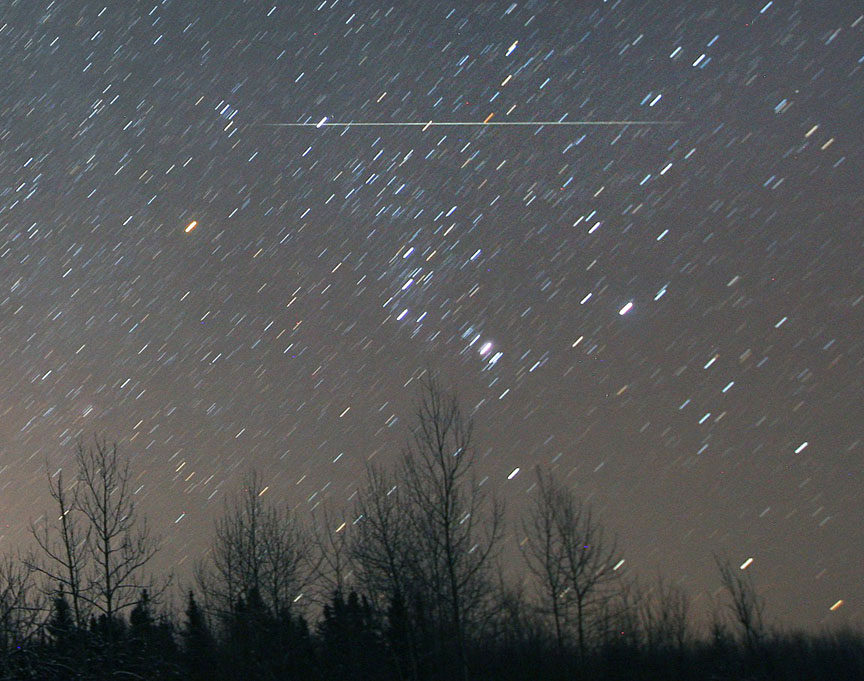
Bob King
Geminids typically arrive singly, but not always. I've seen two at a time or flurries of one a minute followed by no meteors at all for several minutes. For whatever reason, those gaps always feel like eternity. It's as if the shower's has suddenly run out of steam. But then a fireball comes streaking across Orion and you're back in business! During slow spells, you can brush up on your constellations (how many of you can say you've really seen Monoceros?), follow the contours of the winter Milky Way, check in on Comet 46P/Wirtanen, or simply soak up the stars.
The radiant culminates high in the southern sky at 2 a.m. local time and remains well placed until around 5 a.m., the time slot when the maximum number of meteors may be seen.
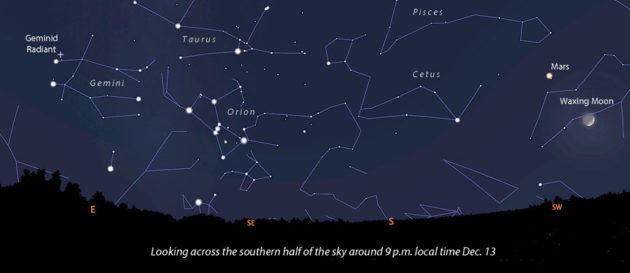
Stellarium
So you've got choices. You can watch early under a bit of moonlight and call it a night. Or if you're feeling more adventurous, get up around two o'clock when the Moon is absent and meteor counts are best. I often split the difference, spending an hour in the evening catching early birds and an hour or two around 2 a.m. when the shower's running hot. No matter when you start your meteor vigil, there's no preferred direction to look. Geminids can appear anywhere in the sky. The one thing they have in common is that all point back to the radiant near the star Castor in Gemini. Those that don't are either sporadic meteors or members of minor, overlapping showers. That said, I like to face to the south or southeast if for no other reason than to have my favorite constellation, Orion, the Hunter, in view.
While the peak is expected early Friday morning the 14th, don't let that stop you from starting to look for Geminids anytime this week. If you run into clouds Thursday, the shower will still be active Friday evening, though with reduced numbers. If you have a digital camera able to do time exposures, try a little photography. You'll need a tripod and a medium-wide angle lens. To avoid dew or frost from clouding the lens, rubber-band a pair of disposable hand warmers around the top and bottom of the lens barrel. Check out our How to Photograph a Meteor Shower guide for more tips.
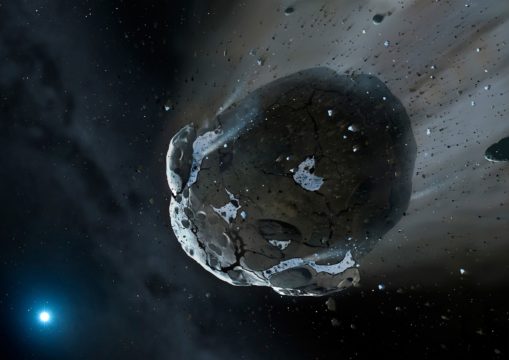
ESA
What makes the Geminids a bit odd is their parent. Most showers stem from icy-dusty debris left behind by periodic comets as they orbit the Sun. Earth intersects the comet's orbit and — voilà! — dust slams into the atmosphere 75-100 kilometers overhead and burns up as meteors.
Geminids are the spawn of the weird "rock comet" asteroid 3200 Phaethon. Like an asteroid, it looks like a point of light without a fuzzy coma, but it passes closer to the Sun at perihelion than any other named asteroid — just 21 million kilometers every 1.4 years. Astronomers speculate that intense solar heating with temperatures reaching 1,500°F (800°C) cause Phaethon to crack and spall, releasing rock dust that spreads around its orbit. As proof of its volatility, the asteroid has been caught sporting a short dust tail twice, in 2009 and 2012.
Amazing, isn't it, how something as remote and impersonal as a 3-mile-wide rock can strike wonder in our hearts. Wishing you all clear skies!
 9
9
Comments
Rod
December 12, 2018 at 10:43 am
Looks like clouds and likely rain for me on Thursday and Friday this week. I may have seen some Geminid early birds on 05-Dec-18. I was out near 2300 EST or 11:00 PM. "While viewing comet 46P/Wirtanen using binoculars and my 90-mm refractor telescope, two Geminid meteors streaked by in Taurus. These were easy unaided eye views. Estimate mv +1.0. Castor is up in Gemini 50 degrees altitude and 85 degrees azimuth so the radiant is up high when I viewed 46P/Wirtanen near 2300 EST and a bit later. Some early Geminids meteors are predicted for this week." On 10-Dec-18, I enjoyed very good views of comet 46P/Wirtanen using my 10-inch near 9:00 PM EST. "Good, large fuzzy shape with bright nucleus perhaps about 0.5 degree fuzzy area visible or larger. Much brighter image in the XT10i than the 90-mm refractor." I used a 2-inch eyepiece at about 35x and 1.8 degree true field of view, very good views. Hopefully others will enjoy the peak of the Geminids this Thursday and Friday. Clouds and rain for me 🙂
You must be logged in to post a comment.
Bob KingPost Author
December 13, 2018 at 1:01 am
Your generous spirit is appreciated, Rod. Too bad you won't see the shower, but glad you caught a few early birds. I noticed a couple late last week. We were supposed to be clouded out, but now the forecast has improved.
You must be logged in to post a comment.
Robert-Casey
December 13, 2018 at 2:27 pm
I'm going to attempt ham radio contacts by bouncing 50MHz signals off meteor trails. This shower should improve the odds of doing "meteor scatter" communications.
You must be logged in to post a comment.
Robert-Casey
December 14, 2018 at 10:01 am
Normally this time of year it's line of sight for 50MHz communications, but with this meteor storm I've seen, from my location in New Jersey, stations in Indiana, Nova Scotia, North Carolina, Ontario, New Hampshire, All about 500 miles distant.
You must be logged in to post a comment.
Dave Mitsky
December 13, 2018 at 11:53 pm
Some of the forecasts offered a glimmer of hope of seeing some of the Geminid meteor shower tonight and, as hard as it may be to believe, that glimmer of hope actually took place! The satellite map seemed good enough for me to make the ten-mile drive to the Naylor Observatory. The sky was hazy when I arrived but was more than clear enough to catch some Geminids. I parked my wife's convertible at the far end of the observatory grounds, parked facing eastward, and dropped the top.
I settled in and began observing at 8:16 p.m. EST. Two minutes later I saw my first meteor. It was fairly bright, perhaps magnitude 1 to magnitude 0. At 8:25 p.m., an even brighter one appeared, between magnitude 0 and magnitude -1. Then there was a somewhat long hiatus until 8:44 p.m. Two minutes after that I witnessed another meteor. By the time an hour had elapsed, I had logged six definite meteors (and two possible ones), all second magnitude or better, one that occurred overhead at 9:04 p.m. being at least as bright as Sirius.
At 9:23 p.m., a bright meteor shot across the zenith magnitude -1 or -2. A minute later an even brighter one, magnitude -2 or better, headed towards the northeastern horizon.
By 9:35 p.m., I had seen 18 meteors.
As the second hour was nearly ending, I noticed clouds beginning to appear near Orion. Looking backwards, I could see the sky was almost completely overcast. At that time, my count was 19 Geminids, the last one shooting from western Gemini into Orion. Before the second hour ended, I witnessed one more bright meteor, bringing my tally to 20 Geminids.
Most of the meteors that I saw were fairly bright and several were possibly magnitude -2 in brightness. All of them were fast and none left persistent trains.
You must be logged in to post a comment.
Rod
December 14, 2018 at 3:39 am
Bob King et al, it was not a total wash here where I am at in Maryland. A note from my trusty stargazing log: "Observed 0245-0305 EST. I was able to see 4 Geminids this morning early. Cirrus and altocumulus clouds cleared up briefly. These meteors flashed by about mv +1.0 moving from Gemini towards Orion and Auriga, comparing their brightness to Castor and Pollux and Orion belt stars. Castor at 0309 EST was up altitude 76 degrees and 244 degrees azimuth for my location so high up. Orion belt stars like epsilon Ori or Alnilam altitude 32 degrees and 236 degrees azimuth for my location. This was fun. The meteors looked similar to the Slooh images from Namibia on 13-Dec I watched during the Slooh webcast on space.com. Webcast started at 1800 EST and ended 2200 EST on 13-Dec-18. It was not a total loss viewing Geminids this year because of cloud coverage in my area. The Slooh images of comet 46P/Wirtanen were very good, especially using the 0.5 meter telescope - larger than my 10-inch 🙂 Now I am going back to bed after viewing some Geminids early this Friday morning."
You must be logged in to post a comment.
Glenn
December 14, 2018 at 8:26 pm
Tropical cloud means no GEM so far in Sydney with only one more chance to view any sort of decent numbers tomorrow morning. And next year a bright moon will be inconveniently placed. Oh well.
The snowflakes furthest from the radiant are the best streaks and could represent the Earthgrazers. Just a thought. And the IMO site will have all the latest GEM observations.... Cheers.
You must be logged in to post a comment.
Johnct174
December 15, 2018 at 10:56 am
I caught it a few nights in a row (mainly from the 8th to the 13th). I was looking at 2am and 5 am here in central Ct.. It was the most spectacular I have ever seen with many short flashes (1 second or so) which were streaking in all directions and almost continuous, and an occasional long streak for a couple seconds. This was with just naked eye viewing.
You must be logged in to post a comment.
Bob KingPost Author
December 15, 2018 at 11:16 am
Hi John,
Sounds spectacular. We had a fantastic show here in Duluth, Minn. Grateful for clear skies!
You must be logged in to post a comment.
You must be logged in to post a comment.